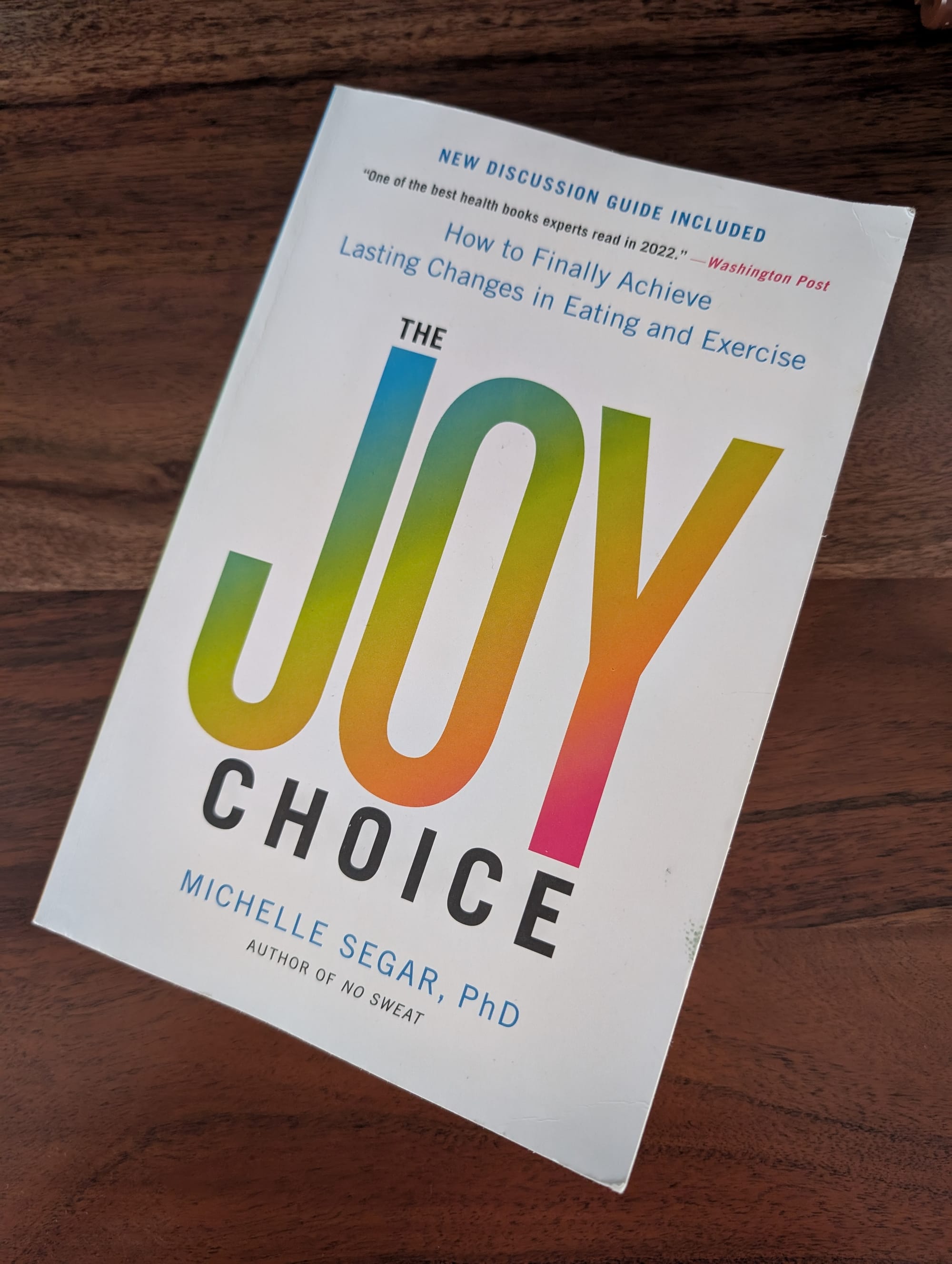Reflections on “The Joy Choice”

Last week I finished reading The Joy Choice by Dr Michelle Segar - a book that claims to offer an alternative approach to health behaviour change, which is actually sustainable. I’ve been following Segar for a long time - she’s a behavioural scientist and health coach, who is a proponent of concepts like “joyful movement”. As I explore this new space, I had high hopes that she might offer a blueprint for the weight-neutral health behaviour change I’m looking for. Was I right? Spoiler alert: mostly - but read on for a summary of the book and my thoughts.
Dismantling the behaviour change paradigm
The first part of the book is about dismantling a lot of the common assumptions around behaviour change. I really enjoyed this, and it really resonated with me (both personally and professionally!). A couple of things in particular stood out:
Automatic “habits” (i.e. doing a specific behaviour in response to a specified cue) don’t work well for everyone, and might not be as valuable as many believe them to be, when it comes to health behaviour. They work well for simple behaviours in predictable contexts: for example when you go to the bathroom in the morning, you brush your teeth. However, for most of us, especially those with lots of responsibilities (e.g. parents), the sheer amount of other (often unanticipated) demands make habits really hard to form and maintain - for example, you might plan to do an exercise class after breakfast every weekday, but sudden work demands, a sick child, or an important phone call might disrupt it. Segar proposes that we need health behaviours to be flexible around unpredictable lives - whereas a lot of prior research into habits relies on predictable contexts (e.g. the same things happen at the same time every day). I think automatic habits can be really powerful, but this issue of our unpredictable lives feels really important. I know my own exercise habits are easily disrupted in this way. There’s been so much emphasis on habits in the last few years (like the obsession with Atomic Habits by James Clear), so Segar’s take felt refreshing.
Many of us have lots of feelings tied up with eating and exercise - usually driven by guilt and shame (from living in a fatphobic culture which values thinness and self-control), or negative experiences (hello memories of PE lessons at school). These interfere with our attempts to change these behaviours, as we’re naturally going to avoid things which have previously made us feel a bit rubbish. This one definitely resonated from a personal point of view - not only the difficult relationship I’ve had with food caused by a lifetime of diets, but also from an exercise point of view. I’ve always been “terrible at sports” - I later discovered that this is largely due to my hypermobility, which causes poor proprioception (difficulties knowing where your body is in space), but the negative experiences of being the worst at everything are still wired into my brain. The fact that exercise can also easily cause me pain and fatigue, just compounds these negative associations.
Decision disruptors
Segar goes on to talk about 4 “decision disruptors” which make us less likely to follow-through on our eating and exercise plans:
- Temptation: we’re drawn to things that have previously been positive experiences (e.g. eating delicious birthday cake, surrounded by friends and family) and away from things which weren’t (e.g. the runs I used to go on when pursuing weight loss)
- Rebellion: we resent feeling controlled, even by rules we set ourselves. We are likely to rebel against “shoulds” - because it feels good, and as though we’re taking control. This is particularly true when we’re changing our eating or exercise behaviour for weight loss reasons.
- Accommodation: We accommodate the needs of others even at the expense of our own (e.g. accepting a piece of cake someone made for you even though you don't really want it; spending time with your kids instead of going for your planned run)
- Perfection: We take a very “all or nothing” approach to health behaviour changes - then when we don’t achieve them, we abandon them altogether (I wrote more about this in my last post)
Segar suggests that even just being aware of these disruptors can help you to overcome them - acknowledge them, and then make an informed decision about what you want to do next. So if you recognise you want the cake because of temptation, you can then decide whether you want to accept that and eat it anyway, or choose something else.
Interestingly, she says that the worst thing we can do is to try and overcome these by using self-control - because it actually makes us feel less confident, puts us back into that perfectionist trap, and reinforces the belief that we can’t do it. So, if you take nothing else away from this - please stop kicking yourself for not having enough self-control!
Solutions
The main solution she proposes is called POP:
- Pause: When you have a choice point about eating and exercise that feels in “conflict” with your plans, take a moment to pause. This helps you to acknowledge potential “disruptors” (see above), and also to move towards making a conscious rather than automatic decision.
- Open up your options and play: if your original plan is scuppered, think about all the other options for what you could do. This helps with flexibility - rather than quitting altogether, think of a alternatives (e.g. dance around the kitchen with the kids instead of going running)
- Pick the joy choice: choose the option which makes you feel most good - not the thing that feels like a “should”.
A fundamental part of her approach (which I actually think gets a little bit lost in the book) is values-based goal setting. Segar quotes recent neuroscience research which shows that when choices are aligned with our identity (who we want to be) and what we value, they're deeply rewarding in the brain. Therefore we need to set higher level goals which are fundamentally important to who we are - for example, having the energy to play with your grandkids. We can then actively choose to protect this goal (what Segar calls “goal shielding”) - rather than needing “self-control”, instead we’re protecting something that’s important to us. I really like this approach to goal setting, and the goal-shielding framing - this is something I’ll definitely be taking forward both personally and in my professional approach.
Is it weight-neutral?
I was concerned when reading the book that this could just be an alternative type of restriction, or a different way to adopt a diet. There is a section relatively early on about weight stigma, and how the pursuit of weight loss makes behaviour change more difficult and unsustainable. However, a lot of the examples around eating behaviour didn’t feel particularly intuitive, and still felt restricting in some way.
Segar does, towards the end of the book, really push the idea of “letting go” of weight loss as a goal, which feels positive. She explains that weight loss and appearance goals are so entwined with weight stigma, the goals become stigmatising in themselves, and not meeting them can evoke shame and self-loathing. This is really helpful and I hope it persuades some people to let go of this; however, I fear that as a society we’re so attached to weight loss as the ultimate achievement, I think there’s a risk that the book lacks some of the things required to actually get people to let go of these - for example, the dismantling of diet culture’s influences on our behaviour, and our perceptions of our bodies. I also think there’s a risk that people could use the POP method to still restrict in some way, which could result in change which is still relatively unsustainable.
Overall, Segar’s method feels pretty compatible with a truly weight-neutral approach, but is at risk of being weaponised for weight-loss - but then, I think this could be true for all approaches (intuitive eating is certainly at risk of being co-opted for weight loss).
What I’m taking away from it
This feels like the closest thing I’ve found to a blend of weight-neutral, intuitive approaches, and behavioural science. I love that Segar’s approach feels like a relatively fresh take, but still grounded in science, with a tonne of academic references as well as case studies from her own coaching practice. I’d love to see more experimental tests of this approach (to see whether it actually does help people to make more sustainable lifestyle changes). As I work to form my own approach and model of supporting health behaviour change, I will certainly be using Segar’s work as a basis, alongside other approaches.
On a personal note, I feel like I’m already bringing some of the flexibility into my choices - particularly “open up your options and play”. I’m hoping it’ll help move me away from the “all or nothing” mindset which I’m definitely guilty of (in all parts of my life, not just health!)
Hopefully this gives you some food for thought regarding your own health behaviour, and how to think about things a bit differently. If you’d like to learn more you can buy the book here.
